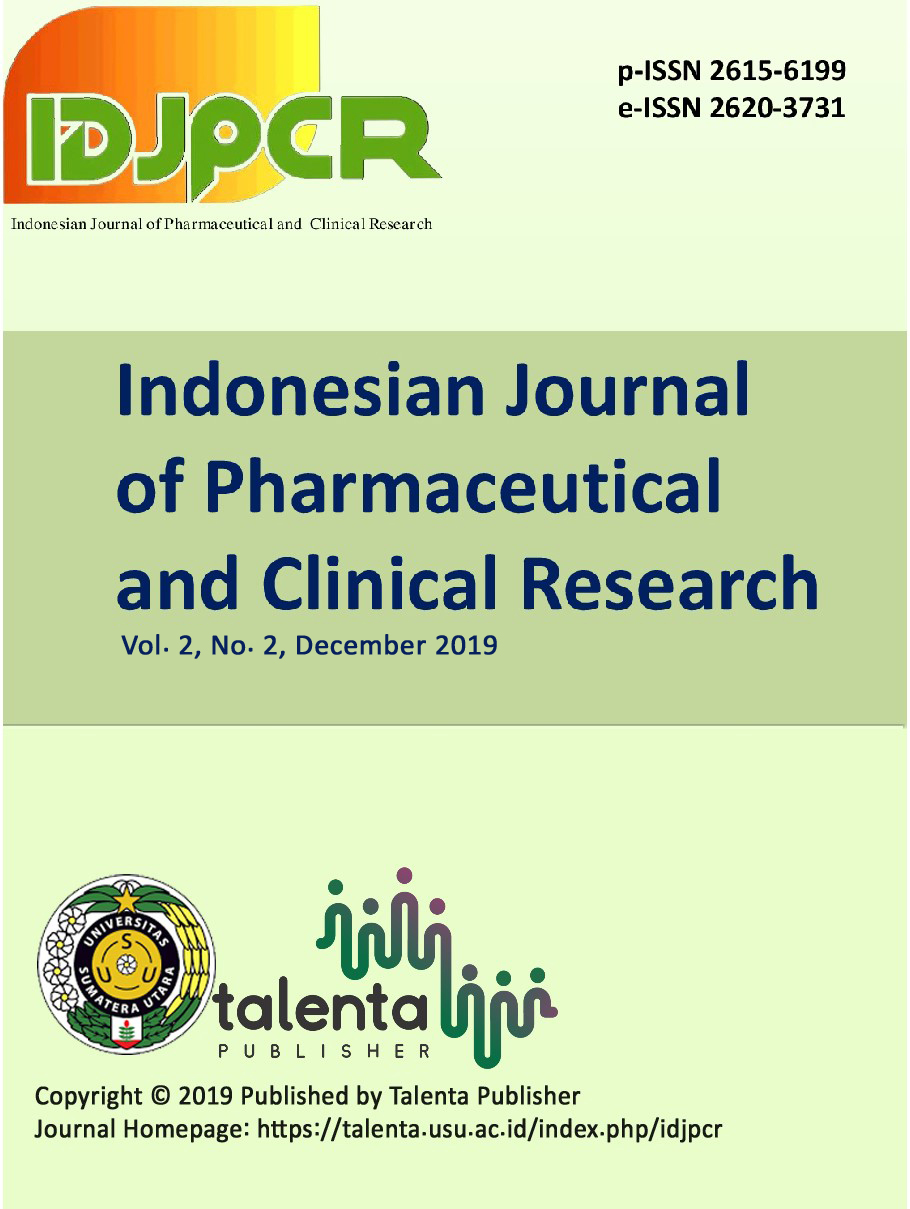The Antioxidant Activity of Pagoda Flower (Clerodendrum paniculatum L.) Ethanol Extract using Visible Spectrophotometric Method
DOI:
https://doi.org/10.32734/idjpcr.v2i2.2060Keywords:
Antioxidant, Clerodendrum Paniculatum L., Visible SpectrophotometricAbstract
Abstract. Pagoda flower is one of the plant species included in the genus Clerodendrum which has a number of different species of 580 species, and is spread evenly in Asia, Africa, America, and Australia. A number of species of this genus have been used in traditional medicine in Asia and Africa. India, China, Korea, Thailand and Japan. The antioxidant activity of this plant is known to be very strong, so in this article the antioxidant activity of the flower part of the Clerodendrum paniculatum L. species will be described. The ability of antioxidant activity was measured by the DPPH method (1,1-diphenyl-2-picrylhydrazyl) which was measured using a Visible spectrophotometer using Vit C as a comparison. The results showed that the ethanol extract of pagoda flowers has antioxidant activity with an IC50 value of 64.889 ppm (strong). The Vit C comparison has an IC50 value of 8.539 ppm (very strong).
Keyword: Antioxidant, Clerodendrum Paniculatum L., Visible Spectrophotometric.
Abstrak. Bunga Pagoda merupakan salah satu spesies tanaman yang termasuk dalam genus Clerodendrum yang memiliki jumlah spesies yang berbeda sejumlah 580 spesies, dan tersebar merata di Asia, Afrika, Amerika, dan Australia. Sejumlah spesies dari genus ini telah digunakan dalam pengobatan tradisional di kawasan Asia dan Afrika. India, China, Korea, Thailand, dan Jepang. Aktivitas antioksidan dari tanaman ini diketahui sangat kuat, sehingga dalam artikel ini akan dipaparkan aktivitas antioksidan yang dimiliki oleh ekstrak etanol bagian bunga dari spesies Clerodendrum paniculatum L. Pengujian aktivitas antioksidanya dilakukan dengan metode DPPH (1,1-diphenyl-2-picrylhydrazyl) yang diukur menggunakan spektrofotometer Visibel dengan menggunakan Vit C sebagai pembanding. Hasil penelitian menjukkan bahwa ekstrak etanol bunga pagoda memiliki aktivitas antioksidan dengan nilai IC50 sebesar 64,898 ppm (kuat). Pembanding Vit C memiliki nilai IC50 sebesar 8,539 ppm (sangat kuat).
Kata Kunci: Antioksidan, Clerodendrum paniculatum L., DPPH, Spektrofotometri Vis.
Downloads
References
[2] Y Marsono. “Prospek pengembangan makanan fungsional,†J. Teknol. Pangan dan Gizi, vol. 7, no. 1, pp. 19-27. 2008.
[3] I Hafiz, Rosidah, and J Silalahi. “Antioxidant and anti-inflammatory activity of pagoda leaves (clerodendrum paniculatum l.) ethanolic extract in white male rats (Rattus novergicus),†Int. J. PharmTech Res., vol. 9, no. 5, pp. 165-170. 2016.
[4] N Shrivastava, T Patel. “Clerodendrum and Heathcare: An Overview,†Med. Aromat. Plant Sci. Biotechnol., vol. 1, no. 1, p. 142-150. 2007.
[5] SS Bhujbal, SMK Kewatkar, LS More, and MJ Patil. “Antioxidant effects of roots of Clerodendrum serratum Linn,†Pharmacognosy Res., vol. 1, no. 5, pp. 294-298. 2009.
[6] MK Singh, G Khare, SK Iyer, G Sharwan, DK Tripathi. “Clerodendrum serratum: A clinical approach,†J. Appl. Pharm. Sci., vol. 2, no. 02, pp. 11–15. 2012.
[7] K Gouthamchandra, R Mahmood, H Manjunatha. “Free radical scavenging, antioxidant enzymes and wound healing activities of leaves extracts from Clerodendrum infortunatum L.,†Environ. Toxicol. Pharmacol., vol. 30, no. 1, pp. 11–18. 2010.
[8] S Gurudeeban, K Satyavani, T Ramanathan, G Umamaheshwari, R Shanmugapriya. “Antioxidant and radical scavenging effect of Clerodendrum inerme (L),†World J Fish Mar Sci, vol. 2, pp. 66–69. 2010.
[9] P Dey, D Chaudhuri, S Tamang, TK Chaudhuri, N Mandal, “In vitro antioxidant and free radical scavenging potential of Clerodendrum viscosum,†Int J Pharm Bio Sci, vol. 3, no. 3, pp. 454–471. 2012.
[10] R Sriranjani et al., “Silver nanoparticle synthesis using Clerodendrum phlomidis leaf extract and preliminary investigation of its antioxidant and anticancer activities,†J. Mol. Liq., vol. 220, pp. 926–930. 2016.
[11] I Hafiz, K Fitri, JH Sipayung. “The Phytochemical Screning and Assesment of Bioactivity of Pagoda Flower (Clerodendrum paniculatum L.) Using Brine Shrimp (Artemia salina) Lethality Assay,†Asian J. Pharm. Res. Dev., vol. 7, no. 3, pp. 10–13. 2019.
[12] W Sumaryono, “Teknologi pembuatan sediaan fitofarmaka skala industri,†War. Tumbuh. Obat Indones., vol. 3, no. 1, 1996.
[13] S Tauseef et al., “In vitro Antioxidant activity analysis of five medicinally important plants,†J. Pharmacogn. Phytochem., vol. 2, no. 4, pp. 183-188. 2013.
[14] SA Widuri, N Noorcahyati, I Mediawati, “Uji Pendahuluan Fitokimia dan Antioksidan Tumbuhan Obat Suku Dayak di Desa Petangis, Kabupaten Paser, Kalimantan Timur,†J. Sains dan Kesehat., vol. 1, no. 6, pp. 299–306. 2016.
Downloads
Published
How to Cite
Issue
Section
License
The Authors submitting a manuscript do so on the understanding that if accepted for publication, copyright of the article shall be assigned to Indonesian Journal of Pharmaceutical and Clinical Research (IDJPCR) and Faculty of Pharmacy as well as TALENTA Publisher Universitas Sumatera Utara as publisher of the journal.
Copyright encompasses exclusive rights to reproduce and deliver the article in all form and media. The reproduction of any part of this journal, its storage in databases and its transmission by any form or media, will be allowed only with a written permission from Indonesian Journal of Pharmaceutical and Clinical Research (IDJPCR).
The Copyright Transfer Form can be downloaded here.
The copyright form should be signed originally and sent to the Editorial Office in the form of original mail or scanned document.









